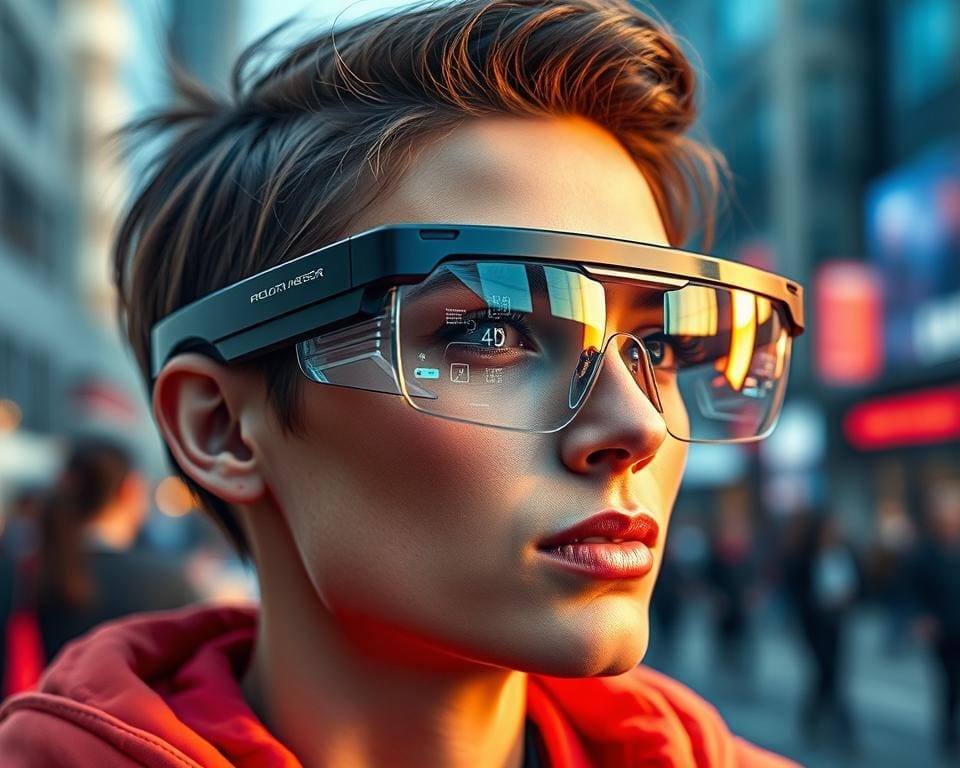In today’s fast-paced world, smart glasses embody a remarkable leap in wearable technology, seamlessly blending physical and digital realms. These augmented reality glasses are not merely a fleeting trend; they hold the potential to transform our daily experiences. By integrating layers of interactive information into our surroundings, smart specs empower users to engage with their environment like never before, enhancing productivity and connectivity.
As industry giants such as Google, Microsoft, and Facebook invest heavily in developing AR eyewear, we witness a growing array of applications ranging from professional solutions to immersive gaming experiences. This article delves into the evolution of smart glasses, exploring their capabilities and the profound impact they can have on our everyday reality.
Understanding Smart Glasses and Their Evolution
Smart eyeglasses have revolutionised the way we interact with technology and the world around us. Their evolution from concept to functional devices showcases a remarkable journey characterised by technological advancements and innovative designs.
From Concept to Reality: The Development of Smart Eyewear
The beginnings of smart eyewear can be traced back to early prototypes in the 1990s. Pioneering efforts in augmented reality led to the release of devices like the Virtuality Group’s head-mounted display in 1999. This groundwork paved the way for more advanced digital eyewear solutions. As technology progressed, products such as Google Glass and Microsoft’s HoloLens emerged, showcasing tangible applications across various sectors. These early adopters set the stage for a dynamic smart glasses market, focusing on usability and compelling user experiences.
Key Players in the Smart Glasses Market
Several key players have established themselves in the smart glasses market, driving innovation and competition. Companies like Google, Microsoft, Apple, and Facebook continue to enhance their offerings, contributing unique features to digital eyewear. Their diverse approaches reflect the growing demand for augmented reality applications in everyday life. As these tech giants vie for consumer attention, the landscape of smart eyeglasses is becoming increasingly exciting and accessible.

What Are Augmented Reality Glasses?
Augmented reality glasses represent a significant advancement in technology, offering unique solutions that transform everyday experiences. These devices utilise AR technology to merge digital information with the physical world, enhancing the user interface in profound ways. Unlike traditional wearable technology, such as fitness trackers and smartwatches that primarily serve practical functionalities, augmented reality glasses elevate interaction by presenting a dynamic overlay of information directly in the user’s line of sight.
Defining Augmented Reality and Its Applications
Augmented reality refers to the integration of digital elements into the real world, creating an enriched experience for users. AR applications span various fields, from gaming and entertainment to education and navigation. For example, in education, AR technology enables interactive learning by bringing complex concepts to life, while in practical settings, navigation applications provide step-by-step directions directly projected into the user’s environment.
Differentiating AR Glasses from Traditional Wearable Technology
While smart glasses share some characteristics with conventional wearable technology, they possess distinct features that set them apart. Traditional devices primarily focus on health metrics, notifications, or media consumption. In contrast, augmented reality glasses are designed for immersive interaction and contextual information display. Key advancements in sensor accuracy, processing power, and display technology distinguish AR glasses, offering unparalleled functionality in various everyday scenarios.
Smart Glasses: Augmenting Your Everyday Reality
Smart glasses represent a transformative step in technology, opening up a world enriched by augmented reality. These devices are not just gadgets; they are tools for enhancing daily life by converting ordinary moments into extraordinary experiences. With hands-free capabilities, smart glasses empower users to access information seamlessly while engaging with their surroundings.
Imagine navigating through a bustling city while receiving turn-by-turn directions directly in your line of sight. This is one of the practical applications of AR technology that showcases how smart glasses facilitate navigation in real time. The convenience of having vital information without needing to check a smartphone fosters a deeper connection to the environment.
Communication is another area where smart glasses shine. By integrating voice commands and visual cues, users can maintain contact with colleagues or friends without interrupting their flow. Whether in a professional setting or during casual encounters, augmented reality enhances interaction, making conversations more engaging and focused.
Productivity gains are evident in collaborative work environments. Smart glasses allow individuals to share their view with others, thus enabling real-time feedback and brainstorming sessions that break down physical barriers. This technology fosters innovation and teamwork, demonstrating the versatility of augmented reality in various contexts.
With their myriad applications, smart glasses are not merely about convenience; they are redefining how we experience daily life. Embracing AR technology encourages a more proactive approach to routine activities, inviting users to explore and engage with their world in refreshing ways. As these devices continue to evolve, the potential for further innovation remains boundless, promising an exciting future for smart glasses.
The Benefits of Using Smart Specs in Daily Life
Smart specs are transforming the way we interact with our environment, leading to greater efficiency and streamlined communication in various scenarios. The integration of technology into eyewear offers not only convenience but a way to enhance our everyday activities significantly.
Enhancing Productivity with Virtual Display Glasses
Virtual display glasses allow users to view crucial information seamlessly. These smart specs project notifications, reminders, and essential updates directly in a person’s line of sight. This feature reduces the need to regularly check smartphones, allowing for a more focused approach to tasks at hand, supporting overall productivity.
Improving Communication through AR Eyewear
AR eyewear presents innovative opportunities for communication. By enabling real-time sharing of experiences and information, these devices redefine how individuals connect. This capability can enhance teleconferencing, education, and healthcare interactions, bridging gaps and making collaborations more effective.
Challenges and Limitations of Smart Glasses
As smart glasses continue to evolve, they bring a mix of opportunities and obstacles that must be navigated. The challenges of smart glasses can significantly influence consumer acceptance and utilisation. Two primary factors warrant in-depth examination: privacy concerns and user comfort.
Addressing Privacy Concerns with Digital Eyewear
Privacy concerns remain a pressing issue in the realm of digital eyewear. The capacity to record and share visual information introduces ethical dilemmas surrounding surveillance and consent. Users often fear they will be unknowingly filmed, leading to increased apprehension about wearing smart glasses in public spaces. In response, manufacturers are encouraged to establish regulations that enhance transparency regarding data usage and collection. By prioritising user privacy, companies will foster trust and encourage broader acceptance of this technology.
Overcoming Technology Limitations for User Comfort
Another significant challenge relates to user comfort, which can hinder the adoption of smart glasses. Many devices are perceived as bulky or uncomfortable for extended wear. Issues such as battery life and the overall weight of the eyewear contribute to a less than optimal experience. As such, ongoing innovation in ergonomic design and lightweight materials is essential. Striking the right balance between functionality and comfort will be crucial in transforming digital eyewear into a staple accessory for everyday life.
The Future of Wearable Technology and AR Eyewear
The future of wearable technology, particularly in AR eyewear, holds immense promise as innovation accelerates the integration of smart glasses into our daily lives. Anticipated advancements include enhanced augmented reality experiences, better battery performance, and more seamless connectivity with other smart devices. With the rapid development of these technologies, consumers can expect increasingly intuitive functionalities that blend effortlessly into modern lifestyles.
As awareness and demand for AR eyewear grow, smart glasses market trends indicate a significant expansion across various sectors such as healthcare, education, and entertainment. Companies like Microsoft with their HoloLens and Google with their latest AR initiatives are spearheading a wave of advancements that emphasise collaboration and creativity, promising a future rich with possibilities.
Moreover, potential partnerships among tech giants could lead to groundbreaking innovations that reshape the landscape of wearable technology. The dynamic interplay between various technologies will not only enhance user experiences but also solidify the enduring significance of AR eyewear as a driving force for forward-thinking solutions in our increasingly digital world.









